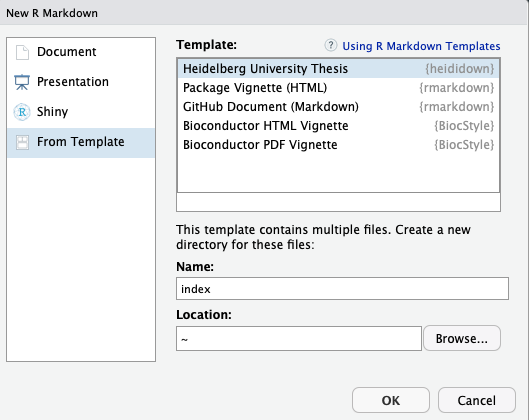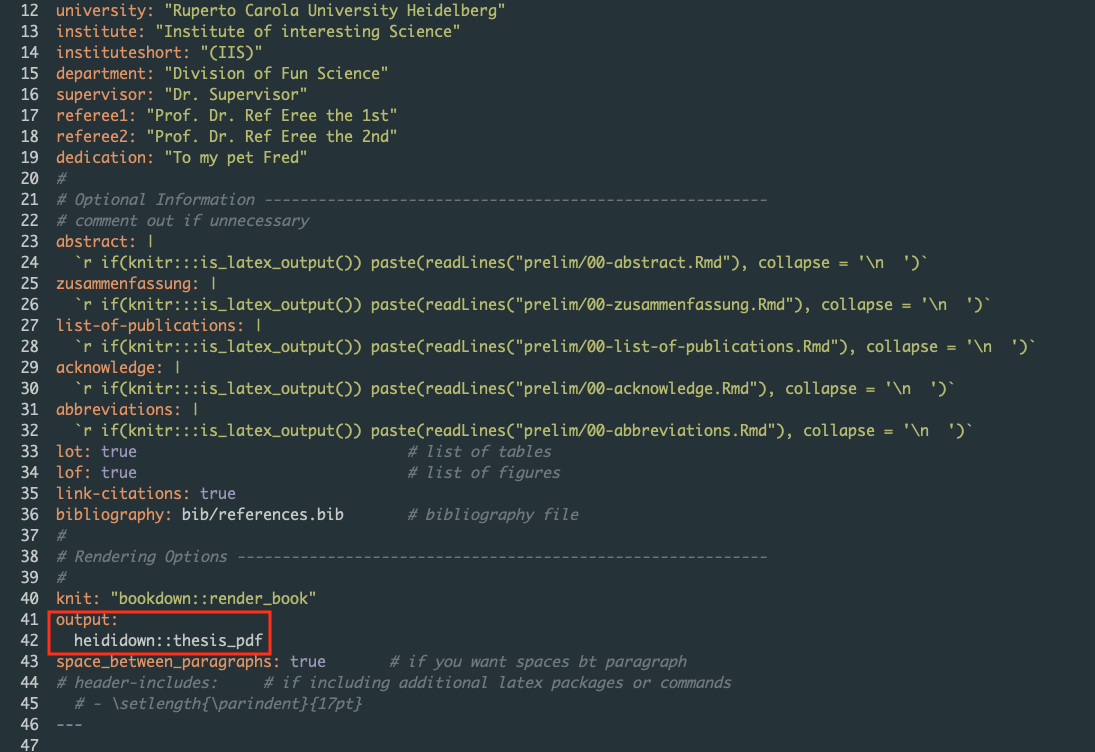The heididown package provides a handy template for writing a dissertation
at the Faculty of Biosciences at Heidelberg University and rendering
those files in a PDF format following the instructions given
here.
It is heavily based on Phi Nguyen's huwiwidown
for writing a dissertation at the Humboldt-Universität zu Berlin School of
Business and Economics which in turn is based on Chester Ismay's
thesisdown.
Users write in R Markdown (which is basically a flavor of the Markdown
markup language but with the ability to incorporate R code chunks using the
knitr package), and the bookdown package (powered by
pandoc ) is used to convert the code into LaTeX code and
finally into a PDF document. There's other formats that can be created too, such
as html documents, but that is outside the scope of this package.
In the event that you've never used bookdown before, check out this handy
tutorial.
Why use this instead of the provided LaTeX template? Though LaTeX is an incredibly powerful tool, the learning curve can be difficult and a lot of time is spent wasted on finding the correct formatting. This package sacrifices some of the expressiveness of LaTeX for the ease of use of Markdown, to allow the end user to focus on writing good content.
Markdown is a much easier-to-use, lightweight, no-frills markup language. The good news is that users can still inject LaTeX code directly into the Markdown pages, in the event he/she still wants to write in LaTeX.
This thesis will contain minor differences to the due to limitations in the pandoc output, but in general the appearance is almost entirely identical. An example of the output can be seen here.
- To install the template, be sure you have the following:
- Install the necessary packages:
if (!require("devtools")) {
install.packages("devtools", repos = "http://cran.rstudio.org")
}
devtools::install_github("rstudio/bookdown")
devtools::install_github("nkurzaw/heididown")- Create a New R Markdown document:
File -> New File -> R Markdown... then choose 'From template', then choose
'Heidelberg Thesis", and enter index as the Name. Note that this will
currently only Knit if you name the directory index at this step.
If you're not using RStudio, navigate to an empty directory and then run the following code:
rmarkdown::draft("index.Rmd", template = "heidelberg_thesis", package = "heididown")- Choose a document style you prefer
The package comes with multiple options to render documents:
- create a book-like pdf appearance with chapters (default, which I personally prefer for dissertations),
- this is done usind the function
heididown::thesis_pdf(default) - to adapt the underlying template, you have to modify the
template.texfile
- this is done usind the function
- create a pdf with sections as highest level organization
- this is done usind the function
heididown::thesis_without_chapter_pdfwhich you specify in theindex.Rmdfile (see image below) - to adapt the underlying template, you have to modify the
template_wo_chap.texfile
- this is done usind the function
- create a pdf with sections as a template for a master of bachelor thesis at the Institute of Pharmacy and Molecular Biotechnology
- this is done usind the function
heididown::thesis_without_chapter_ipmb_pdfwhich you need to specify in theindex.Rmdfile (see image below) - to adapt the underlying template, you have to modify the
template_wo_chap_ipmb.texfile
- this is done usind the function
All options come with no warranty that the output style is in accordance with what the faculty you are submitting your thesis to will accept!! Carefully check if all formal requirements are fullfilled! If you need to adjust things, you can always edit the latex template files underlying the different functions.
To render your thesis, you can open index.Rmd in RStudio and then hit the
"knit" button. Alternatively, you can use:
rmarkdown::render("index.Rmd")Your thesis will be deposited in the thesis-output/ directory.
The following describes the components in the template.
This file is first created when generating a new template. It contains all the relevant meta-information (e.g. name, thesis title, advisor names). You will need to fill out the sections at the top of the page, which will then auto-populate your "Title Page" and "Declaration of Authorship". If you are also familiar with the YAML header, you can also add additional LaTeX parameters or decide whether you want to add optional pages to your thesis such as the "Acknowledgements" section or the "List of Tables".
This is the main configuration file for your thesis. It determines what Rmd
files are included in the output, and in what order. Arrange the order of your
chapters in this file and ensure that the names match the names in your folders.
The first file should always be the index.Rmd file. The rest will be the files
that you create. Some example files are already included to help you along your
way.
These are the sections or chapters that will be bound together in the final
render. Here's where you write the sections that make your thesis. You can name
the files whatever you like, so long as they are indexed in the _bookdown.yml
file.
Note that you will not need to change 98-references.Rmd as the bibliography
will be auto-generated in alphabetically order so long as you cite that item
in the text and your bibliography is correctly located in bib/references.bib.
References should stay in that position to ensure it appears after the text but
before the appendix.
Store your bibliography (as bibtex files) here.
Store your figures and data here and reference them in your R Markdown files.
- Chester Ismay's
thesisdownpackage: thesisdown - Basic R Markdown syntax: R Markdown
- R Markdown reference guide: R Markdown Reference

